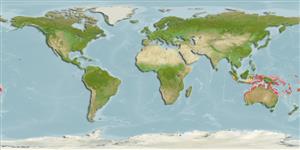Classification / Names
Common names | Synonyms | Catalog of Fishes (gen., sp.) | ITIS | CoL | WoRMS | Cloffa
Actinopterygii (ray-finned fishes) >
Pleuronectiformes (Flatfishes) >
Soleidae (Soles)
Etymology: Soleichthys: Latin, solea = sandal (shoe) + Greek, ichthys = fish (Ref. 45335); serpenpellis: Name from Latin words 'serpen' for snake and 'pellis' for skin; referring to the distinctive ocular-side pigmentation pattern, reminiscent of a snake-skin colour pattern.
Environment / Climate / Range
Ecology
Marine; demersal; depth range 4 - 9 m (Ref. 76812). Tropical, preferred ?
Eastern Indian Ocean to Western Pacific: Australia.
Size / Weight / Age
Maturity: Lm ? range ? - ? cm
Short description
Morphology | Morphometrics
Dorsal
soft rays
(total): 76-84;
Anal
soft rays: 64 - 71;
Vertebrae: 44 - 46. This species is distinguished from its congeners by the following set of characters: vertebrae 44-46; dorsal-fin rays 76-84; anal-fin rays 64-71, lateral-line scales 83-95; on the ocular surface, a series of 6 incomplete, diamond-shaped crossbands that are widest in their mid-sections and wider than respective interspaces between crossbands, and small, brown spots scattered in the interspaces between these crossbands; 3 crossbands on the head; 2 white spots in longitudinal series along the midline of the ocular-side body; 2 elongated ocular side pectoral-fin rays of nearly equal length or with the second fin ray longer than the first; small scales present on bases and proximal halves of elongated ocular-side pectoral-fin rays (Ref. 76812).
Life cycle and mating behavior
Maturity | Reproduction | Spawning | Eggs | Fecundity | Larvae
Munroe, T.A. and S.B. Menke, 2004. Two new soleid flatfishes (Pleuronectiformes: Soleidae: Soleichthys) from Australian waters, with a re-description of Soleichthys microcephalus (Günther). Rec. Aust. Mus. 56:247-258. (Ref. 76812)
IUCN Red List Status (Ref. 115185)
CITES (Ref. 94142)
Not Evaluated
Threat to humans
Harmless
Human uses
More information
Common namesSynonymsMetabolismPredatorsEcotoxicologyReproductionMaturitySpawningFecundityEggsEgg development
Age/SizeGrowthLength-weightLength-lengthLength-frequenciesMorphometricsMorphologyLarvaeLarval dynamicsRecruitmentAbundance
ReferencesAquacultureAquaculture profileStrainsGeneticsAllele frequenciesHeritabilityDiseasesProcessingMass conversion
Tools
Special reports
Download XML
Internet sources
Estimates of some properties based on models
Phylogenetic diversity index (Ref.
82805): PD
50 = 0.5039 [Uniqueness, from 0.5 = low to 2.0 = high].
Bayesian length-weight: a=0.01096 (0.00511 - 0.02351), b=3.06 (2.87 - 3.25), in cm Total Length, based on LWR estimates for this (Sub)family-body shape (Ref.
93245).
Trophic Level (Ref.
69278): 3.4 ±0.4 se; Based on size and trophs of closest relatives
Resilience (Ref.
69278): High, minimum population doubling time less than 15 months (Preliminary K or Fecundity.).
Vulnerability (Ref.
59153): Low to moderate vulnerability (27 of 100) .
